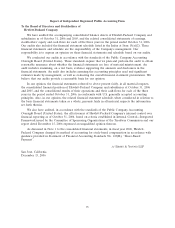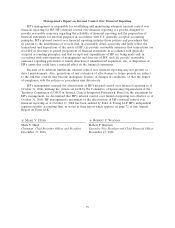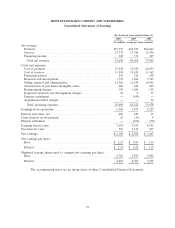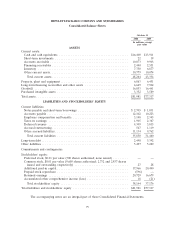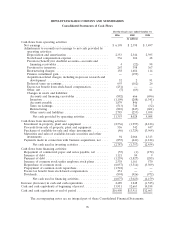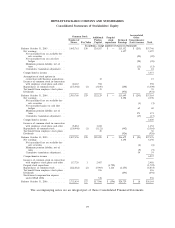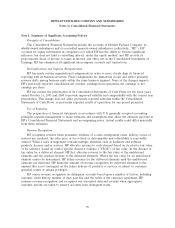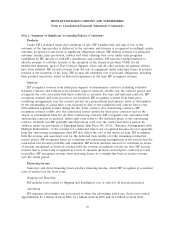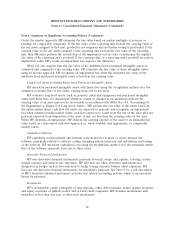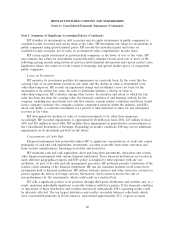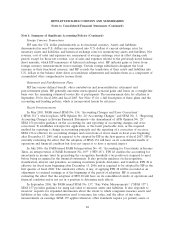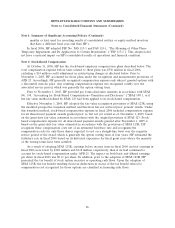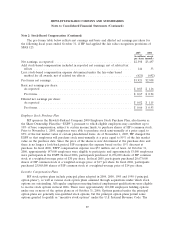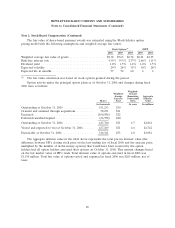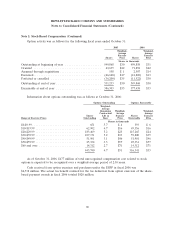HP 2006 Annual Report Download - page 85
Download and view the complete annual report
Please find page 85 of the 2006 HP annual report below. You can navigate through the pages in the report by either clicking on the pages listed below, or by using the keyword search tool below to find specific information within the annual report.HEWLETT-PACKARD COMPANY AND SUBSIDIARIES
Notes to Consolidated Financial Statements (Continued)
Note 1: Summary of Significant Accounting Policies (Continued)
Under the market approach, HP estimates the fair value based on market multiples of revenue or
earnings for comparable companies. If the fair value of the reporting unit exceeds the carrying value of
the net assets assigned to that unit, goodwill is not impaired and no further testing is performed. If the
carrying value of the net assets assigned to the reporting unit exceeds the fair value of the reporting
unit, then HP must perform the second step of the impairment test in order to determine the implied
fair value of the reporting unit’s goodwill. If the carrying value of a reporting unit’s goodwill exceeds its
implied fair value, HP records an impairment loss equal to the difference.
SFAS 142 also requires that the fair value of the indefinite-lived purchased intangible assets be
estimated and compared to the carrying value. HP estimates the fair value of these intangible assets
using an income approach. HP recognizes an impairment loss when the estimated fair value of the
indefinite-lived purchased intangible assets is less than the carrying value.
Long-Lived Assets Including Finite-Lived Purchased Intangible Assets
HP amortizes purchased intangible assets with finite lives using the straight-line method over the
estimated economic lives of the assets, ranging from one to ten years.
HP evaluates long-lived assets, such as property, plant and equipment and purchased intangible
assets with finite lives, for impairment whenever events or changes in circumstances indicate the
carrying value of an asset may not be recoverable in accordance with SFAS No. 144, ‘‘Accounting for
the Impairment or Disposal of Long-Lived Assets.’’ HP assesses the fair value of the assets based on
the undiscounted future cash flow the assets are expected to generate and recognizes an impairment
loss when estimated undiscounted future cash flow expected to result from the use of the asset plus net
proceeds expected from disposition of the asset, if any, are less than the carrying value of the asset.
When HP identifies an impairment, HP reduces the carrying amount of the asset to its estimated fair
value based on a discounted cash flow approach or, when available and appropriate, to comparable
market values.
Capitalized Software
HP capitalizes certain internal and external costs incurred to acquire or create internal use
software, principally related to software coding, designing system interfaces and installation and testing
of the software. HP amortizes capitalized costs using the straight-line method over the estimated useful
lives of the software, generally from one to three years.
Derivative Financial Instruments
HP uses derivative financial instruments, primarily forwards, swaps, and options, to hedge certain
foreign currency and interest rate exposures. HP also may use other derivative instruments not
designated as hedges such as forwards used to hedge foreign currency balance sheet exposures. HP
does not use derivative financial instruments for speculative purposes. See Note 9 for a full description
of HP’s derivative financial instrument activities and related accounting policies, which is incorporated
herein by reference.
Investments
HP’s investments consist principally of time deposits, other debt securities, money market securities
and equity securities of publicly-traded and privately-held companies. HP classifies investments with
maturities of less than one year as short-term investments.
81


